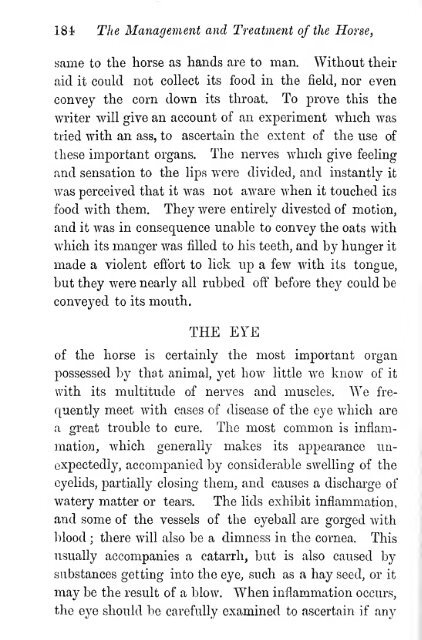The management and treatment of the horse in the stable, field, and ...
The management and treatment of the horse in the stable, field, and ...
The management and treatment of the horse in the stable, field, and ...
Create successful ePaper yourself
Turn your PDF publications into a flip-book with our unique Google optimized e-Paper software.
184 <strong>The</strong> Management <strong>and</strong> Treatment <strong>of</strong> <strong>the</strong> Horse,<br />
same to <strong>the</strong> <strong>horse</strong> as h<strong>and</strong>s are to man. Without <strong>the</strong>ir<br />
aid it could not collect its food <strong>in</strong> <strong>the</strong> <strong>field</strong>, nor even<br />
convey <strong>the</strong> corn down its throat. To prove this <strong>the</strong><br />
writer will give an account <strong>of</strong> an experiment which was<br />
tried with an ass, to ascerta<strong>in</strong> <strong>the</strong> extent <strong>of</strong> <strong>the</strong> use <strong>of</strong><br />
<strong>the</strong>se important organs. <strong>The</strong> nerves which give feel<strong>in</strong>g<br />
<strong>and</strong> sensation to <strong>the</strong> lips were divided, <strong>and</strong> <strong>in</strong>stantly it<br />
was perceived that it was not aware when it touched its<br />
food with <strong>the</strong>m. <strong>The</strong>y were entirely divested <strong>of</strong> motion,<br />
<strong>and</strong> it was <strong>in</strong> consequence unable to convey <strong>the</strong> oats with<br />
which its manger was filled to his teeth, <strong>and</strong> by hunger it<br />
made a violent effort to lick up a few with its tongue,<br />
but <strong>the</strong>y were nearly all rubbed <strong>of</strong>f before <strong>the</strong>y could be<br />
conveyed to its mouth.<br />
THE EYE<br />
<strong>of</strong> <strong>the</strong> <strong>horse</strong> is certa<strong>in</strong>ly <strong>the</strong> most important organ<br />
possessed by that animal, yet how little we know <strong>of</strong> it<br />
with its multitude <strong>of</strong> nerves <strong>and</strong> muscles. We fre-<br />
quently meet with cases <strong>of</strong> disease <strong>of</strong> <strong>the</strong> eye which are<br />
a great trouble to cure. <strong>The</strong> most common is <strong>in</strong>flam-<br />
mation, which generally makes its appearance un-<br />
expectedly, accompanied by considerable swell<strong>in</strong>g <strong>of</strong> <strong>the</strong><br />
eyelids, partially clos<strong>in</strong>g <strong>the</strong>m, <strong>and</strong> causes a discharge <strong>of</strong><br />
watery matter or tears. <strong>The</strong> lids exhibit <strong>in</strong>flammation,<br />
<strong>and</strong> some <strong>of</strong> <strong>the</strong> vessels <strong>of</strong> <strong>the</strong> eyeball are gorged with<br />
blood ; <strong>the</strong>re will also be a dimness <strong>in</strong> <strong>the</strong> cornea. This<br />
usually accompanies a catarrh, but is also caused by<br />
substances gett<strong>in</strong>g <strong>in</strong>to <strong>the</strong> eye, such as a hay seed, or it<br />
may be <strong>the</strong> result <strong>of</strong> a blow. When <strong>in</strong>flammation occurs,<br />
<strong>the</strong> eye should be carefully exam<strong>in</strong>ed to ascerta<strong>in</strong> if any
















